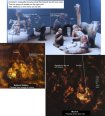|
The study of Rembrandt needs to begin again; ignoring the present system; and relying on a system that uses the datable model groups as the criterion for dating Rembrandt's drawings, regardless of the variety of style they may display. True style is an expression of the artist's complete personality; his beliefs, his education, his personality, his moment in history and his native environment. In Rembrandt's case his belief in the observation of nature is fundamental and very much in tune with the scientists of his time. The tradition of form that he used to probe nature is close to Roman portrait sculpture (he owned 30 original marbles and made drawings from them in two albums - now lost). Roman solid-geometry was extended by Rembrandt to include space as well as solid geometric forms. This is the hall-mark of his style; and an important part of his technical genius that enabled him to define space precisely. The scholars understanding of 'style' falls far short of its full significance. The scholars look at the superficial handwriting of the artist. It does not work - it does not even allow them to distinguish Rembrandt from his followers (eg. David and Solomon). The marks made by an artist vary according to the nature of the pen he happens to be holding , or with the quality of the surface he is drawing on. They are the product of chance. It is wrong to attach too much importance to them. Style is a pattern of thought not just handwriting. (This is too large a subject to discuss now.) During his life-time Rembrandt was frequently criticised for not finishing his pictures properly. He answered this saying "A work of art is finished when the artist has expressed his intention in it." He might have hoped for better treatment from posterity! Modern criticism has put a premium on art that springs from what the experts think of as imagination, that is art made without reference to the outside world. Yet Rembrandt, who must rank very high among imaginative artists, was unable to work satisfactorily "without a living model before his eyes" (Houbraken). Rembrandt had a strong natural bias to work from observation. This is obvious when one studies his drawings and etchings and it is stated over and over again by those who knew Rembrandt. Rembrandt is a weather vane of feeling - his responses are widely varied. Sensibility produces variety. However, it is tacitly denied by the experts. Their desire to purify, (meaning standardize) Rembrandt's work, is enthusiasm grossly misplaced. Rembrandt clearly produces of his best when working from concrete reality “he had a wonderful capacity to reproduce concrete subjects” (Roger de Piles) and a surprising incapacity to construct or imagine without a model to draw from. He could not be further from the kind of artist that modern criticism favours. The attempt to make him conform to modern expectations of imagination has created havoc with his reputation. Rembrandt has been a signpost for all artists since his time and that signpost has been turned to point in the wrong direction, causing great confusion. It is very unlikely that the scholars will take a lead in the process of reform. All this information has been available to the scholars since February 1977 when I published it in The Burlington Magazine with the help of Professor E.H. Gombrich and Dr Jennifer Montagu. Students and the public will have to act themselves to stop the ongoing mistaken view of Rembrandt's working methods. If any good is to be hoped for from the Rembrandt catastrophe it should precipitate a full scale overhaul of the way we arrive at cultural decisions. I would suggest putting artists back in charge. At least that would ensure a wide ranging and heated debate, something that the present regimes of art historians have failed to provide. My experience on the contrary shows, art historians effectively squashing the opposition by their refusal to debate (witness this website). This coupled with the subsidized power and prestige of their exhibitions and publications has made their flawed position – apparently impregnable.
The Museum of Artists’ Secrets consists of important further criticisms of of the way the history of art is handled at present. If you have any questions you would like to raise please email
This e-mail address is being protected from spam bots, you need JavaScript enabled to view it
A DVD is also available, price: £6.00/$12.00 (includes post and packing) and can be requested by contacting Nigel Konstam. The DVD contains about 1 hour of clear demonstrations, illustrations and explanation by Nigel Konstam.
|

|
-
08:14 - 16.02.2010
Nigel's new YouTube Video comments on the Getty Exhibition of 2010
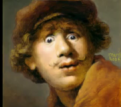
Read more...
-
10:57 - 04.07.2008
See Nigel's YouTube Contribution to the campaign to unseat Sir Nicholas from his 21 Year reign at the Tate Gallery London.
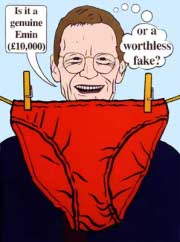
Take this link
Read more...
-
09:53 - 12.10.2007
Click here to watch 5 minute video on the Adoration National Gallery Rejects The Adoration 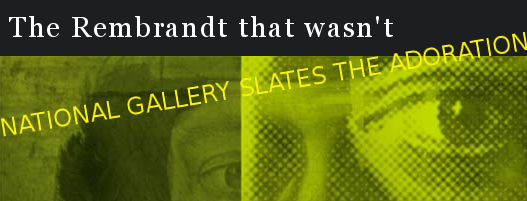 There are two versions of The Adoration of the Shepherds, one in Munich and the second in the National Gallery (London). Both were once attributed to Rembrandt: The Munich version is still a Rembrandt. The London version has been de-attributed by the Rembrandt Research Project (RRP) in spite of the fact that the National Gallery experts examination of the materials confirmed that the painting was from Rembrandt's studio. The object of this demonstration is to prove that the London painting is truly a Rembrandt though the RRP insists that this version cannot possibly be by him. On the right of the photograph you see a maquette made from the figures and architecture in the Munich painting, that Rembrandt observed and painted direct from life. A cow and a basket also form a part of the composition. The reflected part of the photograph you see in the mirror (on the left) matches up with the subject matter of the London painting to such a degree that we cannot doubt that Rembrandt (or whoever else was painting from Rembrandt's precise position) painted what he saw in the mirror. As the use of a mirror can be demonstrated many times in Rembrandt's accepted drawings it is most rational to assume that Rembrandt stayed in the same position and painted both paintings; probably concurrently, with the same palette and brushes. It is amusing to note that while the humans are static, only the cow moved: the hats of the figures remain the same, the basket on the post is seen in elevation in the Munich version and in plan in the London version, the lantern is still carried by the man with the broad brimmed hat, lots of tiny details are transmuted but most of all the infinitely complex space relationship between the figures remains constant. By understanding the extreme complexity of the task of constructing the London subject from the Munich painting, we can be certain that a mirror was used.(This is no simple print image. It is a reversal of a new point of view of the same very complex, three dimensional group we see in the Munich painting.) From this understanding we not only regain a lost Rembrandt, we demonstrate that the impressionistic style of the London painting is also Rembrandt's. Thus widening the stylistic spectrum that has been imposed arbitarily by the RRP. Furthermore it is proved that Rembrandt worked from a theatrical-type production. I believe he set up live models dressed with costumes (mentioned in his inventory of 1656) in the adoration paintings, I believe the scene was staged in a barn. These tableaux-vivants, the very life's blood of Rembrandt's work as artist and teacher, are implicitly denied by the RRP and their followers, who are keepers of Rembrandt drawings in the museums: a fundamental error, which invalidates many of the experts' judgements over the last 100 years. *************** Two legitimate questions may arise from this demonstration 1. did mirrors of this size exist in Rembrandt's time? Answer � not made from one sheet of glass � this large mirror was probably made of polished metal. And 2. Why should he work from an inadequate reflection of his models when he had a group to observe direct from life? Answer � Rembrandt was not alone in the barn. There are student versions of this same scene, both drawn and painted, that show that students were working side by side with the master, each with their own individual viewpoint. This would have inhibited Rembrandt's freedom to move himself or change the group of models. Alternatively, it may just be Rembrandt's explorative spirit that drove him to this single experiment, which he never repeated in painting, but many times while drawing. *************** If you have doubts please look at the rest of this website before submitting your questions. It is my belief that the other end of the spectrum of style in Rembrandt's paintings should also be redefined by testing a painting in The Wallace Collection: The Uncharitable Servant. This painting was once the most highly valued Rembrandt in the world. It has been described as Rembrandt at the extreme limits of his ability, it is not typical of Rembrandt but Rembrandt is a most varied artist and we need to define the outer limits of his variability as precisely as possible. If The Uncharitable Servant, was put through autoradiographic tests this would show us the way the painting had been built up right from the original drawing on canvas, thus establishing a clear attribution. The result of this could be to re-inflate Rembrandt's oeuvres and reputation back to where they both stood 50 years ago. If the London painting turns out not to be a Rembrandt the case for widening the spectrum towards a loose impressionistic style remains imperative.
Read more...
-
23:00 - 09.04.2007
The recent 2 x 60min Channel 4 documentary (shown July 21st, 28th 2007)
(made by Lion Television) including Nigel Konstam's contribution to our understanding of the art of ancient Greece (the revolutionary demonstration of why we can be certain that Phidias and his workshop used body casts as the basis of there life-size, sculptural compositions) in Part II.
You can see the whole story in my book;- SCULPTURE, the Art and the Practice, 2nd edition ISBN 0 – 9523568 or, less completely, on the website www.verrocchio.co.uk
Read more...
-
23:00 - 11.07.2007
Follow this Fast Track Introduction to gain a quick overview of the controversy surrounding Rembrandt scholarship. Or use the menu on the left for exploring the ideas in greater depth The Story of a Discovery
Written by Nigel Konstam
Edited by Nancy Grossman-Telfer Recently Rembrandt scholars have reduced the number of drawings and paintings that they accept as being by Rembrandt by between 50% and 70%. A massive change of opinion from scholars in the past. Why has this happened and where does the truth lie? I have studied this problem for over 35 years. I have come to the conclusion that we are dismissing works that are truly by Rembrandt because of a misunderstanding of his character as an artist. Read More > VIDEOS: PART I: Crude Fake attributed to Rembrandt (2 Minutes) PART II: Genuine brilliant Rembrandt attributed to a Dull Student (2 minutes) Adoration of the Shepherds YouTube video YouTube video challenging Sir Nicholas Serota's directorship of the Tate Gallery The Blindness of the Experts: Rembrandt and Bol 

 This Six Chapter DVD Nigel Konstam reveals Rembrandt's working methods, creative process, interests and values. Nigel takes a critical look at how the Great Master has been reinvented by modern art scholars. - INTRODUCTION - In which we see how scholars' expectations of genius lead to the loss of great works of art. Looking at style rather than human content misleads. -INTRODUCTION -THE DEATHBED OF DAVID -THE VIRGIN AND CHILD
- EXPERIMENT AND CHANGE -JOB -REMBRANDT THE DIRECTOR
- IMAGINATION - Shows how what we admire in Rembrandt's work is observed from life, and what leads scholars to disqualify is made up -ISAAC AND ESAU -REMBRANDT MISUNDERSTOOD -THE LION HUNT
- MIRRORS - The use of mirrors proves that Rembrandt did indeed draw from life and challenges present methods of dating works of art. -MUSICIANS, -MUMMERS, -TWO DRAWINGS (Woman in North Holland Dress) -MANY DRAWINGS (Hagar series) -CONCLUSIONS
- CHRIST RAISING A SICK WOMAN Rembrandt's interests and working method
- THE UNWORTHY WEDDING GUEST Rembrandt shows us the inner thougts of his characters and his own creative process
New for 2010 The Adoration of the Shepherds - Nigel Compares two oil paintings by Rembrandt - one of which has been de-attributed and demonstrates that one is a mirror image of the other. Nigel would like to make a TV documentary to make the position of Rembrandt scholarship better known. His DVD is available now free of charge to anyone interested in making the documentary. (Running time about 1 hour total). The DVD takes the arguments presented here much further. Nigel Konstam, the author and discoverer of the above is available for consultation or participation in the project. LINKS: Rembrandt , Nigel Konstam , mirrors , modern criticism , Adoration , THE DEATHBED OF DAVID , THE VIRGIN AND CHILD ,JOB AND HIS COMFORTERS , ISAAC AND ESAU MUMMERS Hagar series THE UNWORTHY WEDDING GUEST , David anoints Solomon , Museum of Artist's Secrets , Nancy Grossman-Telfer
Read more...
-
10:29 - 24.11.2008
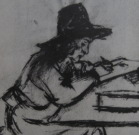
Recent video (Takes only 2 minutes to watch) by Nigel Konstam
Read more...
|






